人教版(2019)必修 第一册Unit 4 Natural Disasters The Night Reading and Thinking 教学设计(表格式)
文档属性
| 名称 | 人教版(2019)必修 第一册Unit 4 Natural Disasters The Night Reading and Thinking 教学设计(表格式) |
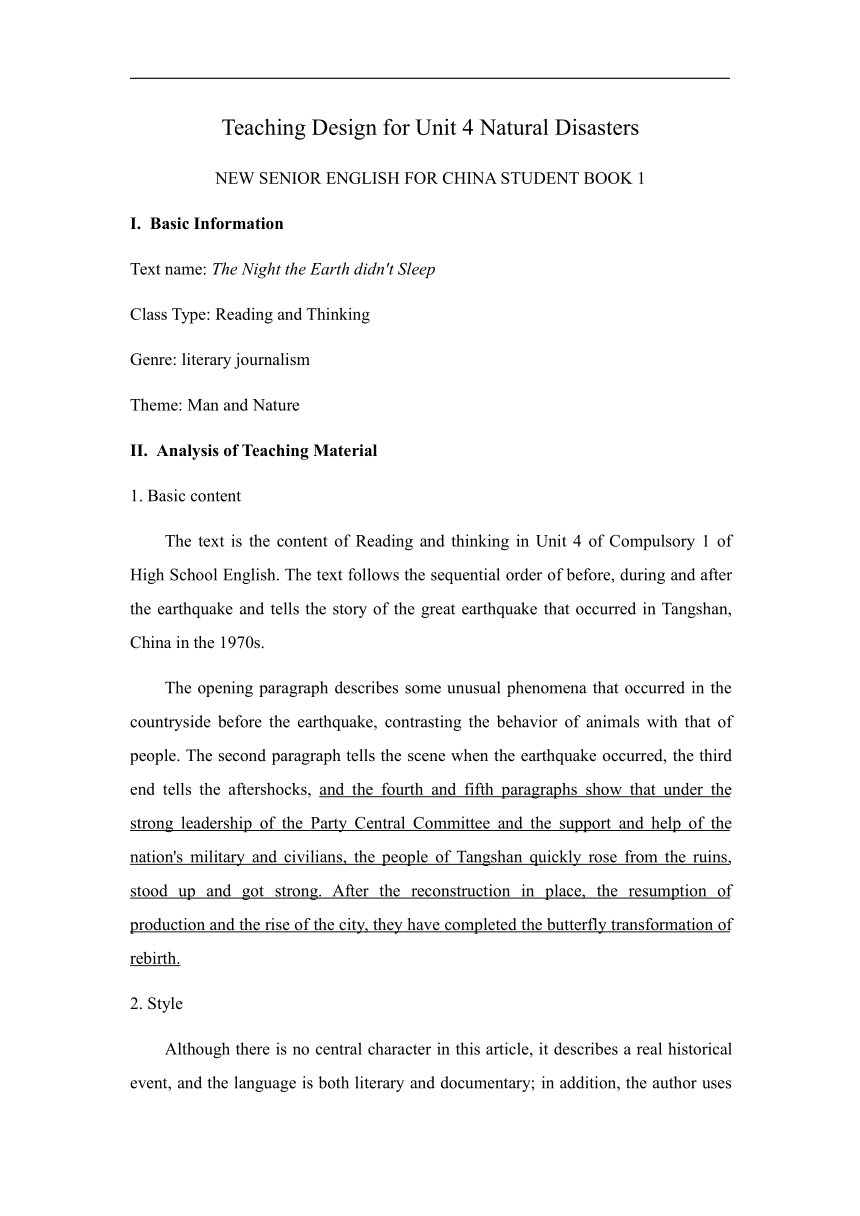
|
|
| 格式 | docx | ||
| 文件大小 | 77.0KB | ||
| 资源类型 | 教案 | ||
| 版本资源 | 人教版(2019) | ||
| 科目 | 英语 | ||
| 更新时间 | 2024-02-20 12:31:51 | ||
图片预览

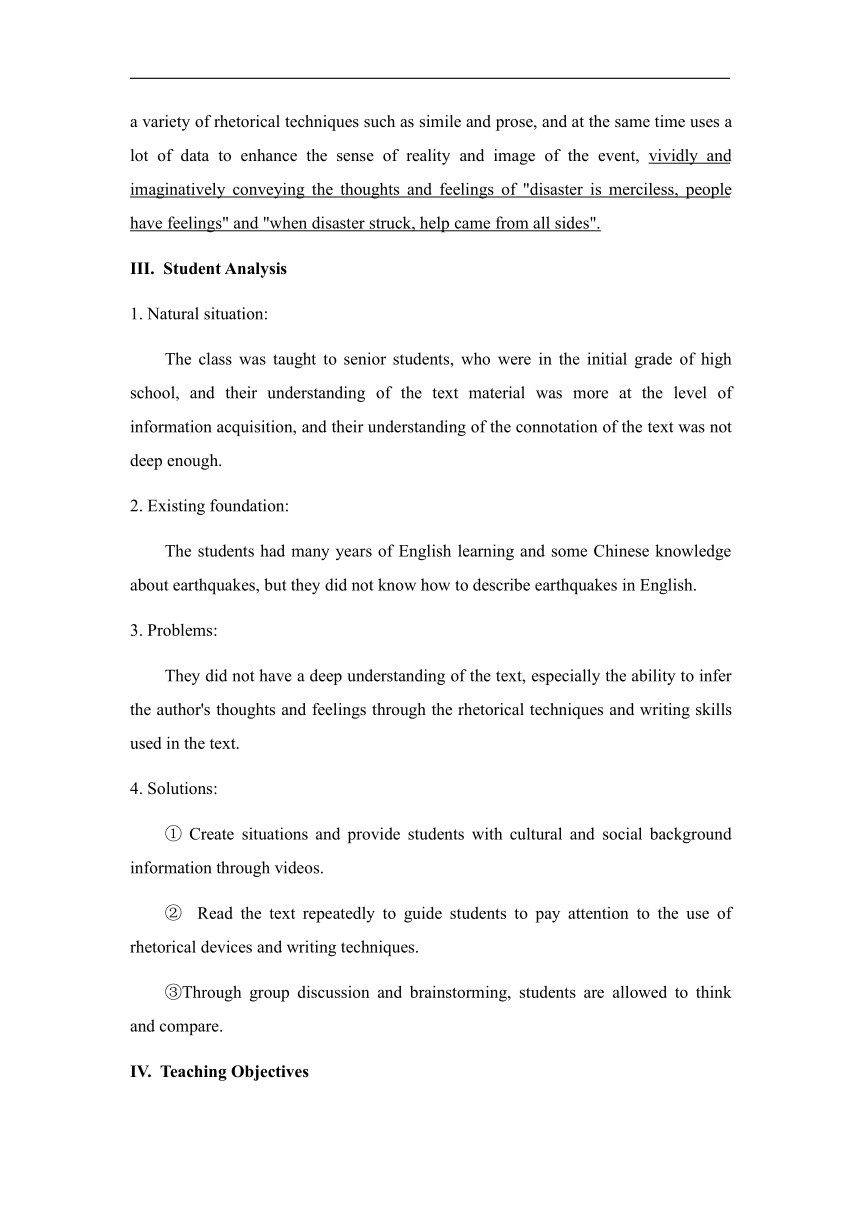
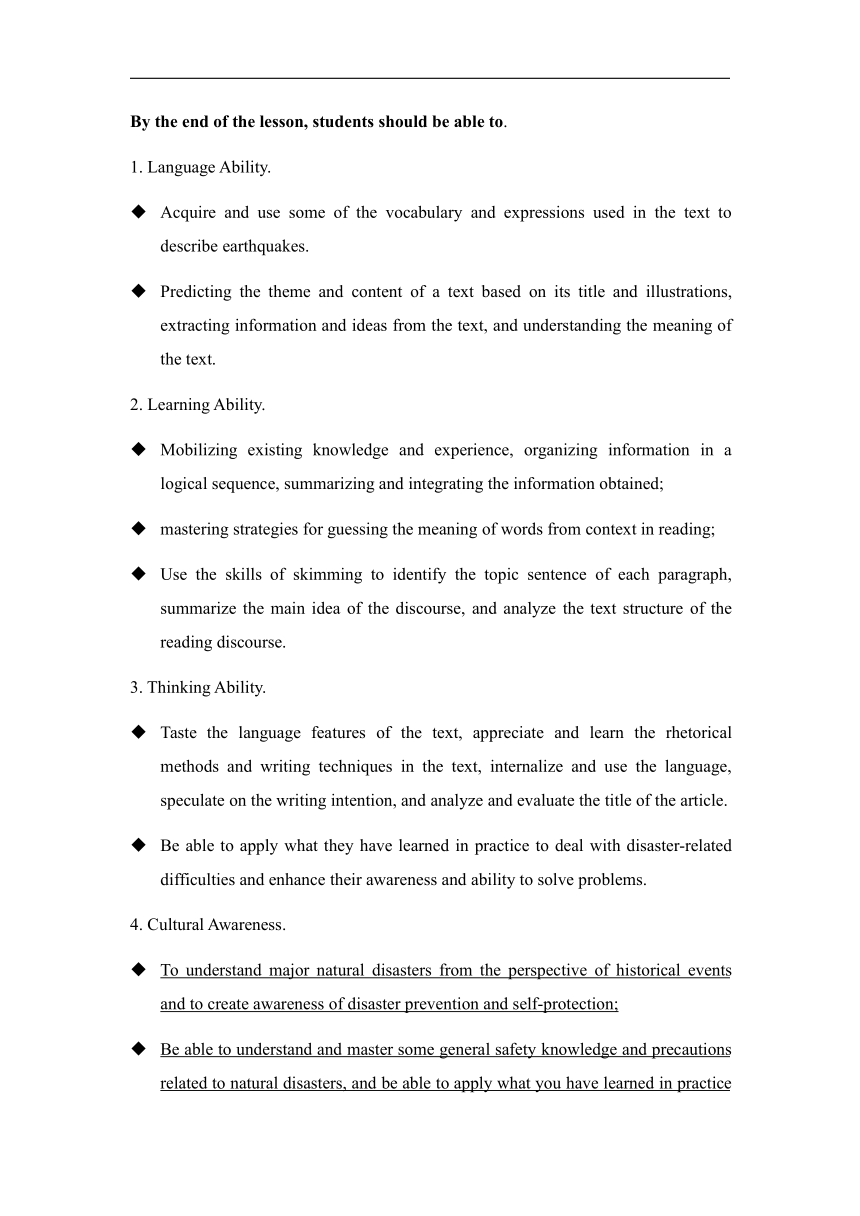
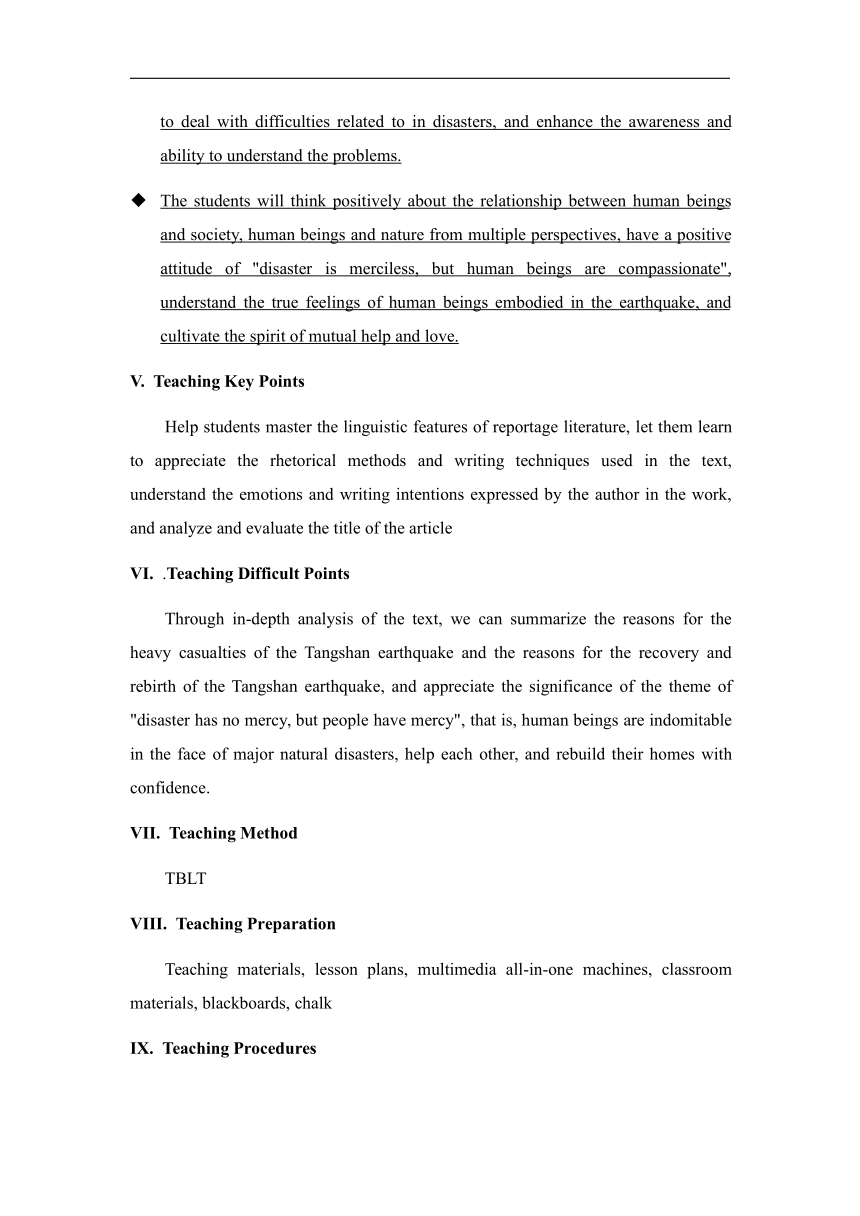
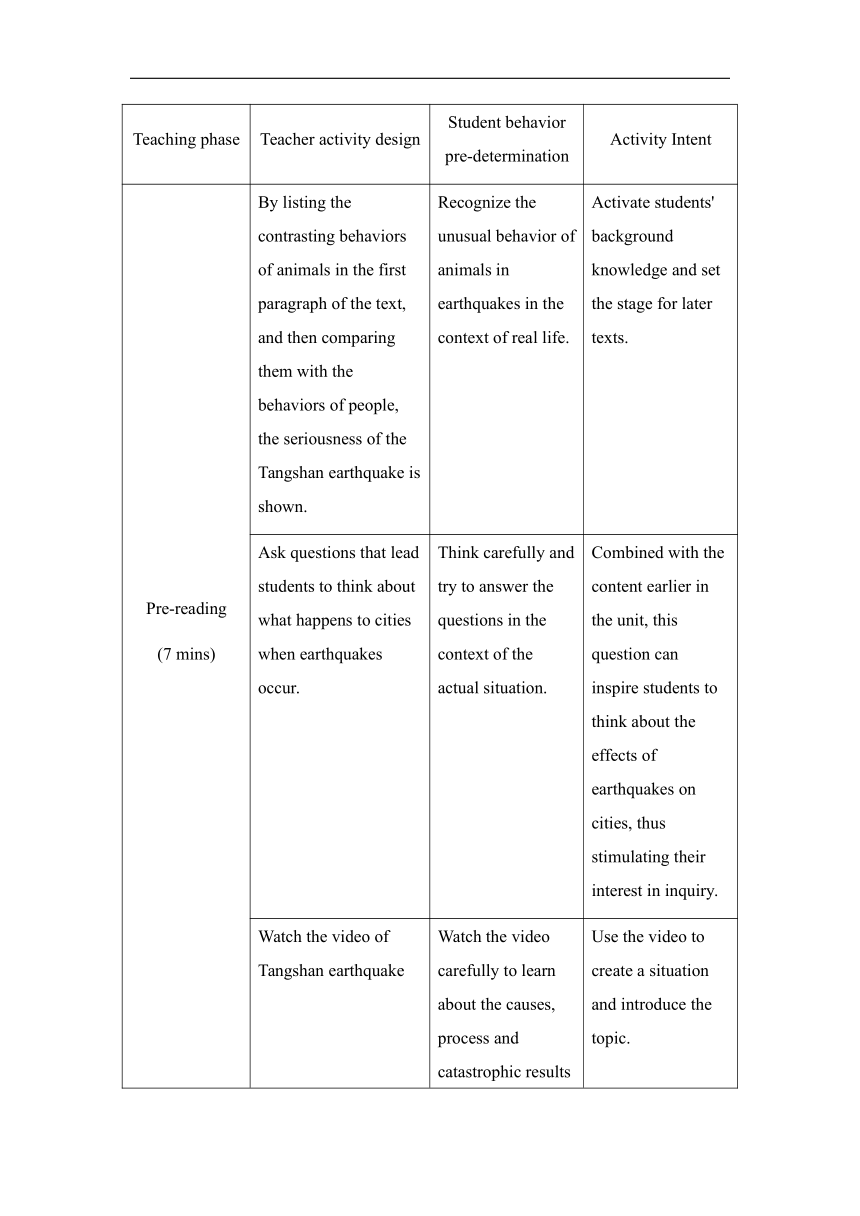
文档简介
Teaching Design for Unit 4 Natural Disasters
NEW SENIOR ENGLISH FOR CHINA STUDENT BOOK 1
Basic Information
Text name: The Night the Earth didn't Sleep
Class Type: Reading and Thinking
Genre: literary journalism
Theme: Man and Nature
Analysis of Teaching Material
1. Basic content
The text is the content of Reading and thinking in Unit 4 of Compulsory 1 of High School English. The text follows the sequential order of before, during and after the earthquake and tells the story of the great earthquake that occurred in Tangshan, China in the 1970s.
The opening paragraph describes some unusual phenomena that occurred in the countryside before the earthquake, contrasting the behavior of animals with that of people. The second paragraph tells the scene when the earthquake occurred, the third end tells the aftershocks, and the fourth and fifth paragraphs show that under the strong leadership of the Party Central Committee and the support and help of the nation's military and civilians, the people of Tangshan quickly rose from the ruins, stood up and got strong. After the reconstruction in place, the resumption of production and the rise of the city, they have completed the butterfly transformation of rebirth.
2. Style
Although there is no central character in this article, it describes a real historical event, and the language is both literary and documentary; in addition, the author uses a variety of rhetorical techniques such as simile and prose, and at the same time uses a lot of data to enhance the sense of reality and image of the event, vividly and imaginatively conveying the thoughts and feelings of "disaster is merciless, people have feelings" and "when disaster struck, help came from all sides".
Student Analysis
1. Natural situation:
The class was taught to senior students, who were in the initial grade of high school, and their understanding of the text material was more at the level of information acquisition, and their understanding of the connotation of the text was not deep enough.
2. Existing foundation:
The students had many years of English learning and some Chinese knowledge about earthquakes, but they did not know how to describe earthquakes in English.
3. Problems:
They did not have a deep understanding of the text, especially the ability to infer the author's thoughts and feelings through the rhetorical techniques and writing skills used in the text.
4. Solutions:
① Create situations and provide students with cultural and social background information through videos.
② Read the text repeatedly to guide students to pay attention to the use of rhetorical devices and writing techniques.
③Through group discussion and brainstorming, students are allowed to think and compare.
Teaching Objectives
By the end of the lesson, students should be able to.
1. Language Ability.
Acquire and use some of the vocabulary and expressions used in the text to describe earthquakes.
Predicting the theme and content of a text based on its title and illustrations, extracting information and ideas from the text, and understanding the meaning of the text.
2. Learning Ability.
Mobilizing existing knowledge and experience, organizing information in a logical sequence, summarizing and integrating the information obtained;
mastering strategies for guessing the meaning of words from context in reading;
Use the skills of skimming to identify the topic sentence of each paragraph, summarize the main idea of the discourse, and analyze the text structure of the reading discourse.
3. Thinking Ability.
Taste the language features of the text, appreciate and learn the rhetorical methods and writing techniques in the text, internalize and use the language, speculate on the writing intention, and analyze and evaluate the title of the article.
Be able to apply what they have learned in practice to deal with disaster-related difficulties and enhance their awareness and ability to solve problems.
4. Cultural Awareness.
To understand major natural disasters from the perspective of historical events and to create awareness of disaster prevention and self-protection;
Be able to understand and master some general safety knowledge and precautions related to natural disasters, and be able to apply what you have learned in practice to deal with difficulties related to in disasters, and enhance the awareness and ability to understand the problems.
The students will think positively about the relationship between human beings and society, human beings and nature from multiple perspectives, have a positive attitude of "disaster is merciless, but human beings are compassionate", understand the true feelings of human beings embodied in the earthquake, and cultivate the spirit of mutual help and love.
Teaching Key Points
Help students master the linguistic features of reportage literature, let them learn to appreciate the rhetorical methods and writing techniques used in the text, understand the emotions and writing intentions expressed by the author in the work, and analyze and evaluate the title of the article
.Teaching Difficult Points
Through in-depth analysis of the text, we can summarize the reasons for the heavy casualties of the Tangshan earthquake and the reasons for the recovery and rebirth of the Tangshan earthquake, and appreciate the significance of the theme of "disaster has no mercy, but people have mercy", that is, human beings are indomitable in the face of major natural disasters, help each other, and rebuild their homes with confidence.
Teaching Method
TBLT
Teaching Preparation
Teaching materials, lesson plans, multimedia all-in-one machines, classroom materials, blackboards, chalk
Teaching Procedures
Teaching phase Teacher activity design Student behavior pre-determination Activity Intent
Pre-reading (7 mins) By listing the contrasting behaviors of animals in the first paragraph of the text, and then comparing them with the behaviors of people, the seriousness of the Tangshan earthquake is shown. Recognize the unusual behavior of animals in earthquakes in the context of real life. Activate students' background knowledge and set the stage for later texts.
Ask questions that lead students to think about what happens to cities when earthquakes occur. Think carefully and try to answer the questions in the context of the actual situation. Combined with the content earlier in the unit, this question can inspire students to think about the effects of earthquakes on cities, thus stimulating their interest in inquiry.
Watch the video of Tangshan earthquake Watch the video carefully to learn about the causes, process and catastrophic results of the Tangshan earthquake. Use the video to create a situation and introduce the topic.
While-reading (25 mins) Reading for gist and structure: Guide students to read the text thoroughly, divide the structure of the paragraphs and find the main idea of each paragraph (Activity 3) Follow the instructions, read the text carefully, delineate the structure of the paragraphs carefully, and complete Activity 3 Guide students to grasp the main idea of the text as a whole through the first reading, sort out the structure and main content of the discourse, and pave the way for in-depth analysis of the text.
Reading for factual information and analysis: Have students read carefully and answer the following questions: A. What do you think helped in the revival of Tangshan city B. What kind of help do you think people who have suffered an earthquake need C. What dose the writer mean by "Slowly, the city began to breathe again " Reread the text and discuss the questions in small groups Based on the theme, students are guided to discuss in small groups to sort out the information in the text and summarize the information: using the big questions as a grasp and the small questions as a lead, so that students can deepen their understanding of the text from multiple perspectives and train their thinking and expression skills.
Reading for language features and writing: Guide students to read the text again and consider the following questions: A. Many sentences in the text give us a picture of the terrible earthquake in Tangshan. B. Numbers are widely used in the text. Why does the author mention so many numbers C. Now how do you understand the title Do you think the title is a good one If not, can you give another title to the text Read the text again, think about it and try to answer the questions in the light of what you have learned. Taste the language of the text The students will appreciate and learn the rhetorical methods and writing techniques in the text, internalize and use the language, speculate on the intent of the writing, and analyze and evaluate the title of the article.
Post-reading (10 mins) Brainstorming. A. Analysis of the causes of Tangshan's recovery B. Consider the superiority of the Chinese system in the light of the epidemic Linking textbooks and practice, epidemic experience and foreign policies for a deeper appreciation. Based on the text, but beyond it, analyze it in the context of self-experience, and experience "disaster is merciless, people have feelings", "one side is in trouble, eight sides support", and so on. Connect the past with recent epidemic events to give students a deep understanding of the superiority of the Chinese system.
Homework (3 mins) Interview. As a young reporter, interview adults around you about memories of natural disasters and related details, and organize the information collected to share your experiences in the next class Finish the homework Students are inspired to learn about disasters from the memories of people around them and to think further about the relationship between people and society and people and nature.
Blackboard Design
The design of the board is simple, intuitive, illustrative and concise to attract students' attention. also presents the important and difficult points of the course accurately and clearly, so that students can recall the whole lesson according to the board.
Teaching Reflection
Advantages:
This lesson is a reading and thinking lesson under the concept of overall teaching of large units, taking unit teaching as a framework, textbook content as a benchmark, the main reliance on discourse, the use of "teaching-learning-assessment" integration in high school English reading as a carrier, assessing its effect on the improvement of students' independent reading ability, responding to the new requirements of the new curriculum for high school English teaching. It provides students with correct reading ideas and methods, helps them understand the text better, develops students' language ability and learning ability under the new curriculum, improves students' thinking quality, provides students with concrete learning help and cognitive guidance, helps them understand and apply what they have learned better, and improves their independent reading ability. At the same time, it improves students' self-confidence and interest in learning and further stimulates their enthusiasm and motivation for learning.
Disadvantages:
Because of the limited time of the course, too little discussion time is given to students, making it difficult for each student to have the opportunity to present themselves and for them to seize the opportunity to exercise themselves.
NEW SENIOR ENGLISH FOR CHINA STUDENT BOOK 1
Basic Information
Text name: The Night the Earth didn't Sleep
Class Type: Reading and Thinking
Genre: literary journalism
Theme: Man and Nature
Analysis of Teaching Material
1. Basic content
The text is the content of Reading and thinking in Unit 4 of Compulsory 1 of High School English. The text follows the sequential order of before, during and after the earthquake and tells the story of the great earthquake that occurred in Tangshan, China in the 1970s.
The opening paragraph describes some unusual phenomena that occurred in the countryside before the earthquake, contrasting the behavior of animals with that of people. The second paragraph tells the scene when the earthquake occurred, the third end tells the aftershocks, and the fourth and fifth paragraphs show that under the strong leadership of the Party Central Committee and the support and help of the nation's military and civilians, the people of Tangshan quickly rose from the ruins, stood up and got strong. After the reconstruction in place, the resumption of production and the rise of the city, they have completed the butterfly transformation of rebirth.
2. Style
Although there is no central character in this article, it describes a real historical event, and the language is both literary and documentary; in addition, the author uses a variety of rhetorical techniques such as simile and prose, and at the same time uses a lot of data to enhance the sense of reality and image of the event, vividly and imaginatively conveying the thoughts and feelings of "disaster is merciless, people have feelings" and "when disaster struck, help came from all sides".
Student Analysis
1. Natural situation:
The class was taught to senior students, who were in the initial grade of high school, and their understanding of the text material was more at the level of information acquisition, and their understanding of the connotation of the text was not deep enough.
2. Existing foundation:
The students had many years of English learning and some Chinese knowledge about earthquakes, but they did not know how to describe earthquakes in English.
3. Problems:
They did not have a deep understanding of the text, especially the ability to infer the author's thoughts and feelings through the rhetorical techniques and writing skills used in the text.
4. Solutions:
① Create situations and provide students with cultural and social background information through videos.
② Read the text repeatedly to guide students to pay attention to the use of rhetorical devices and writing techniques.
③Through group discussion and brainstorming, students are allowed to think and compare.
Teaching Objectives
By the end of the lesson, students should be able to.
1. Language Ability.
Acquire and use some of the vocabulary and expressions used in the text to describe earthquakes.
Predicting the theme and content of a text based on its title and illustrations, extracting information and ideas from the text, and understanding the meaning of the text.
2. Learning Ability.
Mobilizing existing knowledge and experience, organizing information in a logical sequence, summarizing and integrating the information obtained;
mastering strategies for guessing the meaning of words from context in reading;
Use the skills of skimming to identify the topic sentence of each paragraph, summarize the main idea of the discourse, and analyze the text structure of the reading discourse.
3. Thinking Ability.
Taste the language features of the text, appreciate and learn the rhetorical methods and writing techniques in the text, internalize and use the language, speculate on the writing intention, and analyze and evaluate the title of the article.
Be able to apply what they have learned in practice to deal with disaster-related difficulties and enhance their awareness and ability to solve problems.
4. Cultural Awareness.
To understand major natural disasters from the perspective of historical events and to create awareness of disaster prevention and self-protection;
Be able to understand and master some general safety knowledge and precautions related to natural disasters, and be able to apply what you have learned in practice to deal with difficulties related to in disasters, and enhance the awareness and ability to understand the problems.
The students will think positively about the relationship between human beings and society, human beings and nature from multiple perspectives, have a positive attitude of "disaster is merciless, but human beings are compassionate", understand the true feelings of human beings embodied in the earthquake, and cultivate the spirit of mutual help and love.
Teaching Key Points
Help students master the linguistic features of reportage literature, let them learn to appreciate the rhetorical methods and writing techniques used in the text, understand the emotions and writing intentions expressed by the author in the work, and analyze and evaluate the title of the article
.Teaching Difficult Points
Through in-depth analysis of the text, we can summarize the reasons for the heavy casualties of the Tangshan earthquake and the reasons for the recovery and rebirth of the Tangshan earthquake, and appreciate the significance of the theme of "disaster has no mercy, but people have mercy", that is, human beings are indomitable in the face of major natural disasters, help each other, and rebuild their homes with confidence.
Teaching Method
TBLT
Teaching Preparation
Teaching materials, lesson plans, multimedia all-in-one machines, classroom materials, blackboards, chalk
Teaching Procedures
Teaching phase Teacher activity design Student behavior pre-determination Activity Intent
Pre-reading (7 mins) By listing the contrasting behaviors of animals in the first paragraph of the text, and then comparing them with the behaviors of people, the seriousness of the Tangshan earthquake is shown. Recognize the unusual behavior of animals in earthquakes in the context of real life. Activate students' background knowledge and set the stage for later texts.
Ask questions that lead students to think about what happens to cities when earthquakes occur. Think carefully and try to answer the questions in the context of the actual situation. Combined with the content earlier in the unit, this question can inspire students to think about the effects of earthquakes on cities, thus stimulating their interest in inquiry.
Watch the video of Tangshan earthquake Watch the video carefully to learn about the causes, process and catastrophic results of the Tangshan earthquake. Use the video to create a situation and introduce the topic.
While-reading (25 mins) Reading for gist and structure: Guide students to read the text thoroughly, divide the structure of the paragraphs and find the main idea of each paragraph (Activity 3) Follow the instructions, read the text carefully, delineate the structure of the paragraphs carefully, and complete Activity 3 Guide students to grasp the main idea of the text as a whole through the first reading, sort out the structure and main content of the discourse, and pave the way for in-depth analysis of the text.
Reading for factual information and analysis: Have students read carefully and answer the following questions: A. What do you think helped in the revival of Tangshan city B. What kind of help do you think people who have suffered an earthquake need C. What dose the writer mean by "Slowly, the city began to breathe again " Reread the text and discuss the questions in small groups Based on the theme, students are guided to discuss in small groups to sort out the information in the text and summarize the information: using the big questions as a grasp and the small questions as a lead, so that students can deepen their understanding of the text from multiple perspectives and train their thinking and expression skills.
Reading for language features and writing: Guide students to read the text again and consider the following questions: A. Many sentences in the text give us a picture of the terrible earthquake in Tangshan. B. Numbers are widely used in the text. Why does the author mention so many numbers C. Now how do you understand the title Do you think the title is a good one If not, can you give another title to the text Read the text again, think about it and try to answer the questions in the light of what you have learned. Taste the language of the text The students will appreciate and learn the rhetorical methods and writing techniques in the text, internalize and use the language, speculate on the intent of the writing, and analyze and evaluate the title of the article.
Post-reading (10 mins) Brainstorming. A. Analysis of the causes of Tangshan's recovery B. Consider the superiority of the Chinese system in the light of the epidemic Linking textbooks and practice, epidemic experience and foreign policies for a deeper appreciation. Based on the text, but beyond it, analyze it in the context of self-experience, and experience "disaster is merciless, people have feelings", "one side is in trouble, eight sides support", and so on. Connect the past with recent epidemic events to give students a deep understanding of the superiority of the Chinese system.
Homework (3 mins) Interview. As a young reporter, interview adults around you about memories of natural disasters and related details, and organize the information collected to share your experiences in the next class Finish the homework Students are inspired to learn about disasters from the memories of people around them and to think further about the relationship between people and society and people and nature.
Blackboard Design
The design of the board is simple, intuitive, illustrative and concise to attract students' attention. also presents the important and difficult points of the course accurately and clearly, so that students can recall the whole lesson according to the board.
Teaching Reflection
Advantages:
This lesson is a reading and thinking lesson under the concept of overall teaching of large units, taking unit teaching as a framework, textbook content as a benchmark, the main reliance on discourse, the use of "teaching-learning-assessment" integration in high school English reading as a carrier, assessing its effect on the improvement of students' independent reading ability, responding to the new requirements of the new curriculum for high school English teaching. It provides students with correct reading ideas and methods, helps them understand the text better, develops students' language ability and learning ability under the new curriculum, improves students' thinking quality, provides students with concrete learning help and cognitive guidance, helps them understand and apply what they have learned better, and improves their independent reading ability. At the same time, it improves students' self-confidence and interest in learning and further stimulates their enthusiasm and motivation for learning.
Disadvantages:
Because of the limited time of the course, too little discussion time is given to students, making it difficult for each student to have the opportunity to present themselves and for them to seize the opportunity to exercise themselves.
